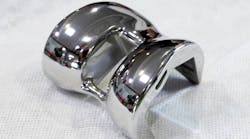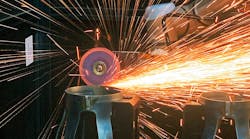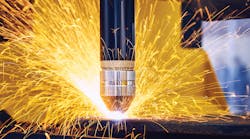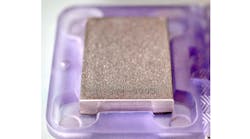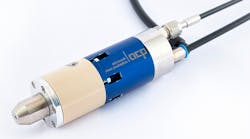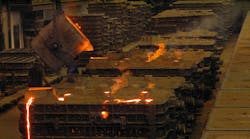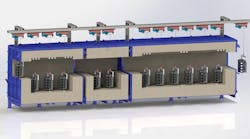The rising volume of cast aluminum parts for automotive drivetrain, powertrain, suspension, and structural applications has initiated a number of other changes in metalcasting operations, lately in the requirements for heat-treating those castings. Automakers’ determination to design and produce lighter vehicles has guided their selection of various aluminum alloys for such applications, but many such alloys require hardening (i.e., heat treatment) in order to fulfill the demands of those new applications.
The necessity of heat-treating these parts is one consideration for high-pressure diecasting (HPDC) operations producing them, but installing an effective heat-treating process that meets the high-throughput requirements is a parallel concern. High-pressure diecasting is very productive, and produces quality complex parts, but conventional atmospheric heat-treatment is not feasible for HPDC parts because trapped gases within them may result in “blistering” under pressure. To address the situation, an E.U.-sponsored research project has developed and introduced a new fluidized-bed process for homogeneous heat-treatment over the entire casting surface, with no more than a 3ºC surface-temperature deviation.
Engine blocks are the outstanding example of HPDC aluminum parts, and presently these castings are heat-treated using a conventional, two-stage process: castings are air-cooled and then reheated in high-temperature ovens, then hardened in lower-temperature ovens.
Heat-treating HPDC parts will enhance their mechanical properties and make it possible to adopt materials and designs that are lighter than comparable iron castings.
The E.U.’s interest in the project aimed to support efforts to reduce CO2 emissions by 2%, by replacing iron castings in passenger vehicles, as well as to reduce CO2 emission associated with gas consumption in alternative heat-treatment processes by 30%.
The core concept of the HardALU heat-treatment system is a fluidized bed: the hardening process gas is forced through a bed of fine sand particles, initiating a fluid-like behavior in that medium. Then, the HPDC parts are submerged into the mixture (a “quenching” process) so that the entire surface of the piece is fully in contact with the sand in the fluidized bed. This achieve the homogeneity noted above.
Temperatures of 490°-540°C (915°-1005°F) can be reached in seven to 10 minutes for large engine blocks, according to the process developers, with heat-transfer rate three to four times higher than conventional forced-air hardening techniques.
“This fluidization of the sand proved to be the project’s biggest challenge, leading to many tests and modifications,” recalled HardALU project manager Jaume Tort. “Ultimately, we got the sand to fluidize correctly with the support of the University Carlos III in Madrid.”
The project also collaborated with the Spanish industrial research center IK4 Azterlan, where the system components were validated and the heat-treated parts were tested.
The developers claim that, thanks to the technology, HPDC parts which could not be heat-treated now can be hardened effectively. This reduces casting wall thicknesses, and thus overall weight, resulting in lower vehicle fuel-consumption — which in turn lowers CO2 emissions.
Additionally, heat-treatment time is reduced compared to alternative processes, resulting in lower industrial electrical consumption.
The system was installed and continues to operate in an industrial location, where testing continues. It is available for demonstration to potential customers.
“What is especially exciting about the future is that the technology is sparking a wider growth in aluminum diecasting for structural parts, such as the shock tower of a car’s suspension,” according to Tort. “This is a breakthrough because complex parts like these are very thin, and so depend on effective thermal treatment to remain robust and reliable.”

